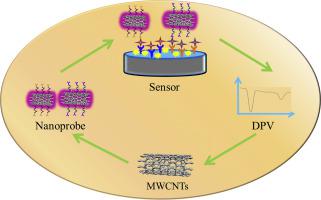Reactive & Functional Polymers ( IF 4.5 ) Pub Date : 2020-05-29 , DOI: 10.1016/j.reactfunctpolym.2020.104632 Na Wang , Xiaoqing Zhao , Hou Chen , Liangjiu Bai , Hui Xu , Wenxiang Wang , Huawei Yang , Donglei Wei , Lixia Yang

|
A functional electrochemical immunosensor was successfully designed for simultaneous and high sensitivity detection of carcinoembryonic antigen (CEA) and α-fetoprotein (AFP). This electrochemical immunosensor was mainly designed by surface-initiated poly(glycidyl methacrylate) (PGMA) from multi-walled carbon nanotubes (MWCNTs) with the methodology of mussel-inspired chemistry (polydopamine, PDA) and metal-free photoinduced electron transfer-atom transfer radical polymerization (PET-ATRP). Controlled PGMA was initiated from MWCNTs, in which Br-functional PDA-modified MWCNTs and eosin Y (EY) were used as initiator and photocatalyst, respectively. The epoxy group of PGMA is reacted with ethylenediamine (EDA) by a ring-opening reaction, the amino and hydroxyl groups in the polymer chain provide numerous effective binding sites for carboxyl groups of signal molecules and capture antibodies, realizing highly sensitive electrochemical detection. Under optimized conditions, the obtained hybrid nanoprobes (Aq/PGMA-g-MWCNTs and Fc/PGMA-g-MWCNTs) were used as efficient electrochemical immunosensor to simultaneously detect CEA and AFP. It is worth noting that the electrochemical immunosensor performed a wide detection range and a low detection limit of CEA (163 fg/mL ~ 163 ng/mL, 56.1 fg/mL) and AFP (100 fg/mL ~ 100 ng/mL, 32.8 fg/mL), respectively. This high sensitivity and selectivity detection platform has a potential application in the simultaneous detection of more tumor markers.
中文翻译:

贻贝启发化学和表面引发的PET-ATRP制备新型电化学免疫传感器,用于同时检测CEA和AFP
成功设计了一种功能性电化学免疫传感器,用于同时,高灵敏度检测癌胚抗原(CEA)和甲胎蛋白(AFP)。该电化学免疫传感器主要是由贻贝启发式化学方法(聚多巴胺,PDA)和无金属的光致电子转移-原子转移技术,通过多壁碳纳米管(MWCNT)的表面引发的聚甲基丙烯酸缩水甘油酯(PGMA)设计的。自由基聚合(PET-ATRP)。受控的PGMA由多壁碳纳米管引发,其中Br-官能PDA修饰的多壁碳纳米管和曙红Y(EY)分别用作引发剂和光催化剂。PGMA的环氧基通过开环反应与乙二胺(EDA)反应,聚合物链中的氨基和羟基为信号分子的羧基和捕获抗体提供了许多有效的结合位点,从而实现了高灵敏度的电化学检测。在优化条件下,获得的杂交纳米探针(Aq / PGMA-g- MWCNT和Fc / PGMA- g- MWCNT被用作有效的电化学免疫传感器,以同时检测CEA和AFP。值得注意的是,电化学免疫传感器的检测范围较宽,而CEA(163 fg / mL〜163 ng / mL,56.1 fg / mL)和AFP(100 fg / mL〜100 ng / mL,32.8)的检测限较低fg / mL)。这种高灵敏度和选择性的检测平台在同时检测更多肿瘤标志物方面具有潜在的应用前景。











































 京公网安备 11010802027423号
京公网安备 11010802027423号